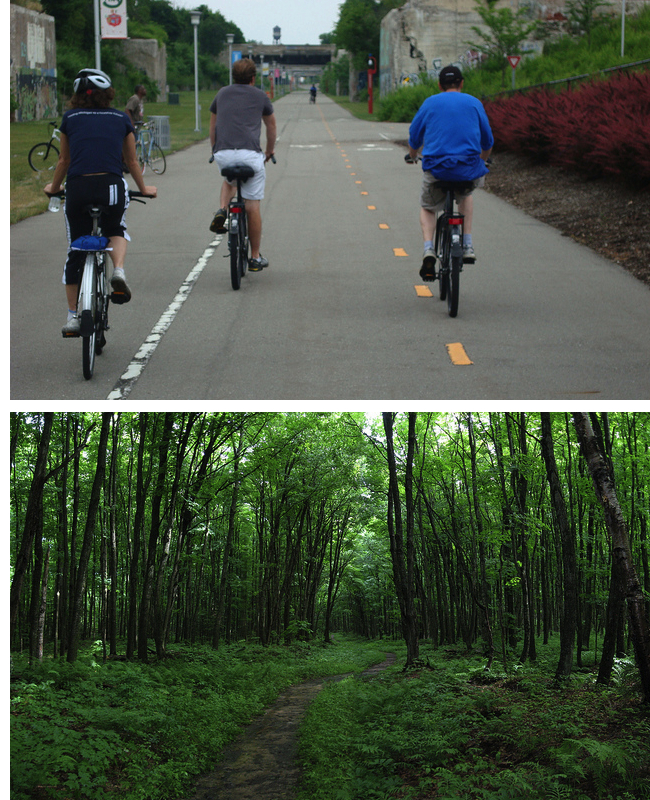Cutting a new trail for the Pure Michigan economy
It’s a long way from Detroit to the Upper Peninsula’s western border, but like all journeys, it begins with a single step.
And on this road, that’s how much of the journey will go – on foot.
When Gov. Rick Snyder announced, late last year, plans for a recreational trail to stretch from Detroit’s Belle Isle to the Wisconsin border, it sounded like a daunting proposition. But by linking existing stretches already in place, the 924-mile distance would require only about 233 more miles of construction, 152 in the Upper Peninsula. And that, state officials say, won’t be as difficult as it might sound.
“One of the first big steps we did is develop a timeline,” said Ron Olson, chief of the Parks and Recreation division of the state Department of Natural Resources. “We think it will take three to five years to complete this.”
Building 233 miles of trail isn’t as daunting as the same length of road. Many stretches will make use of abandoned railroad tracks, Olson said, in rails-to-trails conversions that have become popular in recent years. Other stretches will likely go through existing parks, which DNR officials hope will create new opportunities for tourism and related economic activity.
For now, though, the proposal is still in its early stages. The DNR has been working with local groups and drafting a strategic plan that “should be available fairly soon,” Olson said. That will be followed by a public comment period and then defined action steps.
The first map of the proposed route runs from Detroit along various trails and greenways until it reaches the Bay City area, cuts across to Midland and then moves north along the Midland to Mackinac Boy Scout Trail. In the U.P., it will run along the southern shore of Lake Superior before cutting inland and ending at Ironwood.
When completed, the trail won’t cater to a single type of user. Todd Scott, Detroit coordinator for the Michigan Trails & Greenways Alliance, said it won’t be bike-friendly for its full length. Many sections will be for foot traffic only, particularly in the Upper Peninsula, where it will likely incorporate parts of the North Country Trail, the longest national scenic trail in the nation. It isn’t open to anything other than hiking on foot.
“Our volunteers were quite concerned about that,” said Bruce Matthews, executive director of the North Country Trail, which has its headquarters in Lowell. The seven-state trail “shares a tread” with many others along its 4,600-mile length, but except for short stretches open to bikes and horses, it is for foot traffic only.
But long walks on foot are growing in popularity, spurred by pop culture. Cheryl Strayed’s “Wild,” an account of hiking the Pacific Crest Trail, followed Bill Bryson’s “A Walk in the Woods,” about his attempt to cover the Appalachian Trail. The film “The Way” starred Martin Sheen as a man hiking the Camino de Santiago in Spain and France to deal with the death of his son. Whether driven by fitness, exploration or spiritual healing, so-called “thru-hikers” have helped make long trails popular destinations.
Olson said local governments near the proposed route have expressed interest in being near the yet-to-be constructed stretches.
“It helps the local communities and the tourism,” he said, adding that he also expects at least some resistance in places. Some farmers and land owners in adjoining land may object to foot traffic coming close by, “but it’s more popular than not. We have proven these trails are good neighbors.”
Funding for land acquisition and construction will come from a variety of sources, local and federal, he said, including monies for developing alternatives to automotive travel and the state’s Natural Resources Trust Fund, but “first we have to figure out what we need dollars for. We don’t have a budget yet.”
See what new members are saying about why they donated to Bridge Michigan:
- “In order for this information to be accurate and unbiased it must be underwritten by its readers, not by special interests.” - Larry S.
- “Not many other media sources report on the topics Bridge does.” - Susan B.
- “Your journalism is outstanding and rare these days.” - Mark S.
If you want to ensure the future of nonpartisan, nonprofit Michigan journalism, please become a member today. You, too, will be asked why you donated and maybe we'll feature your quote next time!


 END TO END: A recreational trail from Detroit to the Wisconsin border won’t be the same along its full length. Urban sections will likely look like – or include – the Dequindre Cut trail through Detroit, top, while Upper Peninsula portions may encompass parts of the North Country Trail, below, which is closed to bicycles. (Photos by Flickr users ahealthiermi, top, and Anapko, bottom; both used under Creative Commons license)
END TO END: A recreational trail from Detroit to the Wisconsin border won’t be the same along its full length. Urban sections will likely look like – or include – the Dequindre Cut trail through Detroit, top, while Upper Peninsula portions may encompass parts of the North Country Trail, below, which is closed to bicycles. (Photos by Flickr users ahealthiermi, top, and Anapko, bottom; both used under Creative Commons license)